Contract Law: Essentials, Case Laws and Analysis
VerifiedAdded on 2023/06/10
|12
|2352
|203
AI Summary
This article provides an in-depth analysis of contract law, covering topics such as invitation to treat, agreement, rules of communication, and essentials of contract. It also includes case laws and their implications.
Contribute Materials
Your contribution can guide someone’s learning journey. Share your
documents today.
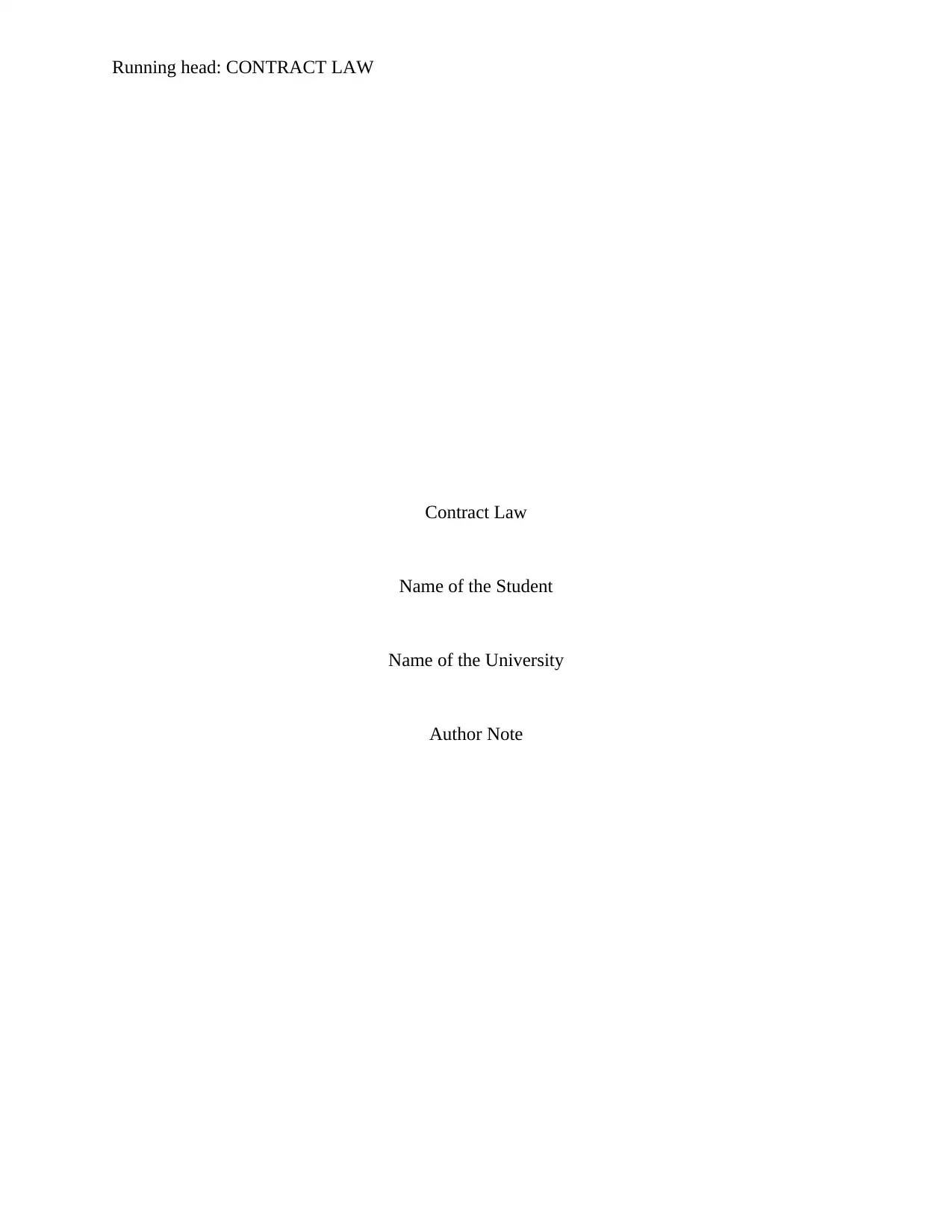
Running head: CONTRACT LAW
Contract Law
Name of the Student
Name of the University
Author Note
Contract Law
Name of the Student
Name of the University
Author Note
Secure Best Marks with AI Grader
Need help grading? Try our AI Grader for instant feedback on your assignments.

1CONTRACT LAW
Table of Contents
Response to Question 1...................................................................................................................2
Invitation to treat or offer:...........................................................................................................2
Agreement between Bill and Frank:............................................................................................2
Agreement between Mark and Frank: Rules of Communication: Rejection of offer..................2
Agreement between John and Mark: Rule of Electronic Communication..................................3
Agreement between Tom and Frank: Electronic communication...............................................4
Conclusion:..................................................................................................................................5
Response to Question 2...................................................................................................................6
Essentials of Contract:.................................................................................................................6
Consideration offered to Renee:..................................................................................................7
Case laws:....................................................................................................................................7
Conclusion...................................................................................................................................8
Table of Contents
Response to Question 1...................................................................................................................2
Invitation to treat or offer:...........................................................................................................2
Agreement between Bill and Frank:............................................................................................2
Agreement between Mark and Frank: Rules of Communication: Rejection of offer..................2
Agreement between John and Mark: Rule of Electronic Communication..................................3
Agreement between Tom and Frank: Electronic communication...............................................4
Conclusion:..................................................................................................................................5
Response to Question 2...................................................................................................................6
Essentials of Contract:.................................................................................................................6
Consideration offered to Renee:..................................................................................................7
Case laws:....................................................................................................................................7
Conclusion...................................................................................................................................8
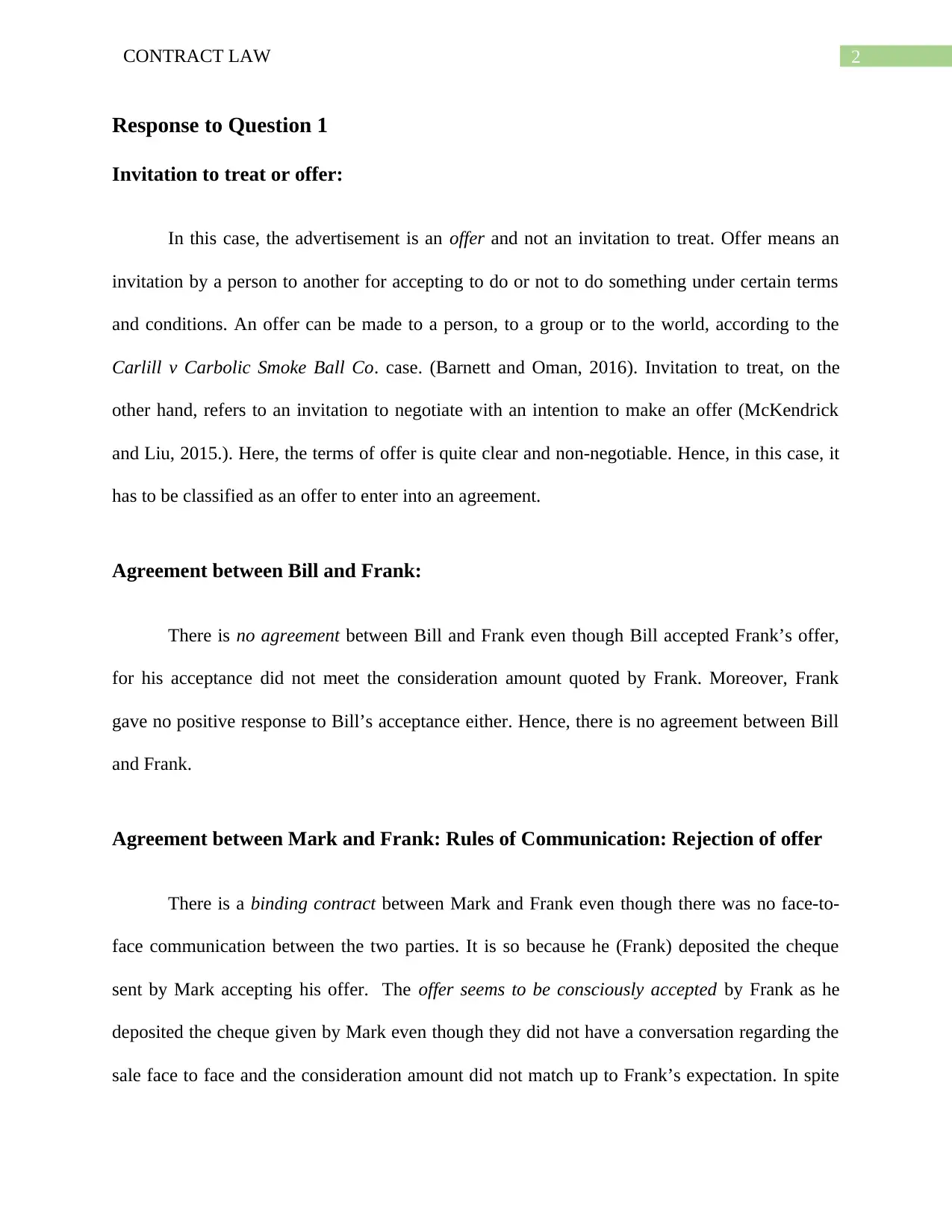
2CONTRACT LAW
Response to Question 1
Invitation to treat or offer:
In this case, the advertisement is an offer and not an invitation to treat. Offer means an
invitation by a person to another for accepting to do or not to do something under certain terms
and conditions. An offer can be made to a person, to a group or to the world, according to the
Carlill v Carbolic Smoke Ball Co. case. (Barnett and Oman, 2016). Invitation to treat, on the
other hand, refers to an invitation to negotiate with an intention to make an offer (McKendrick
and Liu, 2015.). Here, the terms of offer is quite clear and non-negotiable. Hence, in this case, it
has to be classified as an offer to enter into an agreement.
Agreement between Bill and Frank:
There is no agreement between Bill and Frank even though Bill accepted Frank’s offer,
for his acceptance did not meet the consideration amount quoted by Frank. Moreover, Frank
gave no positive response to Bill’s acceptance either. Hence, there is no agreement between Bill
and Frank.
Agreement between Mark and Frank: Rules of Communication: Rejection of offer
There is a binding contract between Mark and Frank even though there was no face-to-
face communication between the two parties. It is so because he (Frank) deposited the cheque
sent by Mark accepting his offer. The offer seems to be consciously accepted by Frank as he
deposited the cheque given by Mark even though they did not have a conversation regarding the
sale face to face and the consideration amount did not match up to Frank’s expectation. In spite
Response to Question 1
Invitation to treat or offer:
In this case, the advertisement is an offer and not an invitation to treat. Offer means an
invitation by a person to another for accepting to do or not to do something under certain terms
and conditions. An offer can be made to a person, to a group or to the world, according to the
Carlill v Carbolic Smoke Ball Co. case. (Barnett and Oman, 2016). Invitation to treat, on the
other hand, refers to an invitation to negotiate with an intention to make an offer (McKendrick
and Liu, 2015.). Here, the terms of offer is quite clear and non-negotiable. Hence, in this case, it
has to be classified as an offer to enter into an agreement.
Agreement between Bill and Frank:
There is no agreement between Bill and Frank even though Bill accepted Frank’s offer,
for his acceptance did not meet the consideration amount quoted by Frank. Moreover, Frank
gave no positive response to Bill’s acceptance either. Hence, there is no agreement between Bill
and Frank.
Agreement between Mark and Frank: Rules of Communication: Rejection of offer
There is a binding contract between Mark and Frank even though there was no face-to-
face communication between the two parties. It is so because he (Frank) deposited the cheque
sent by Mark accepting his offer. The offer seems to be consciously accepted by Frank as he
deposited the cheque given by Mark even though they did not have a conversation regarding the
sale face to face and the consideration amount did not match up to Frank’s expectation. In spite
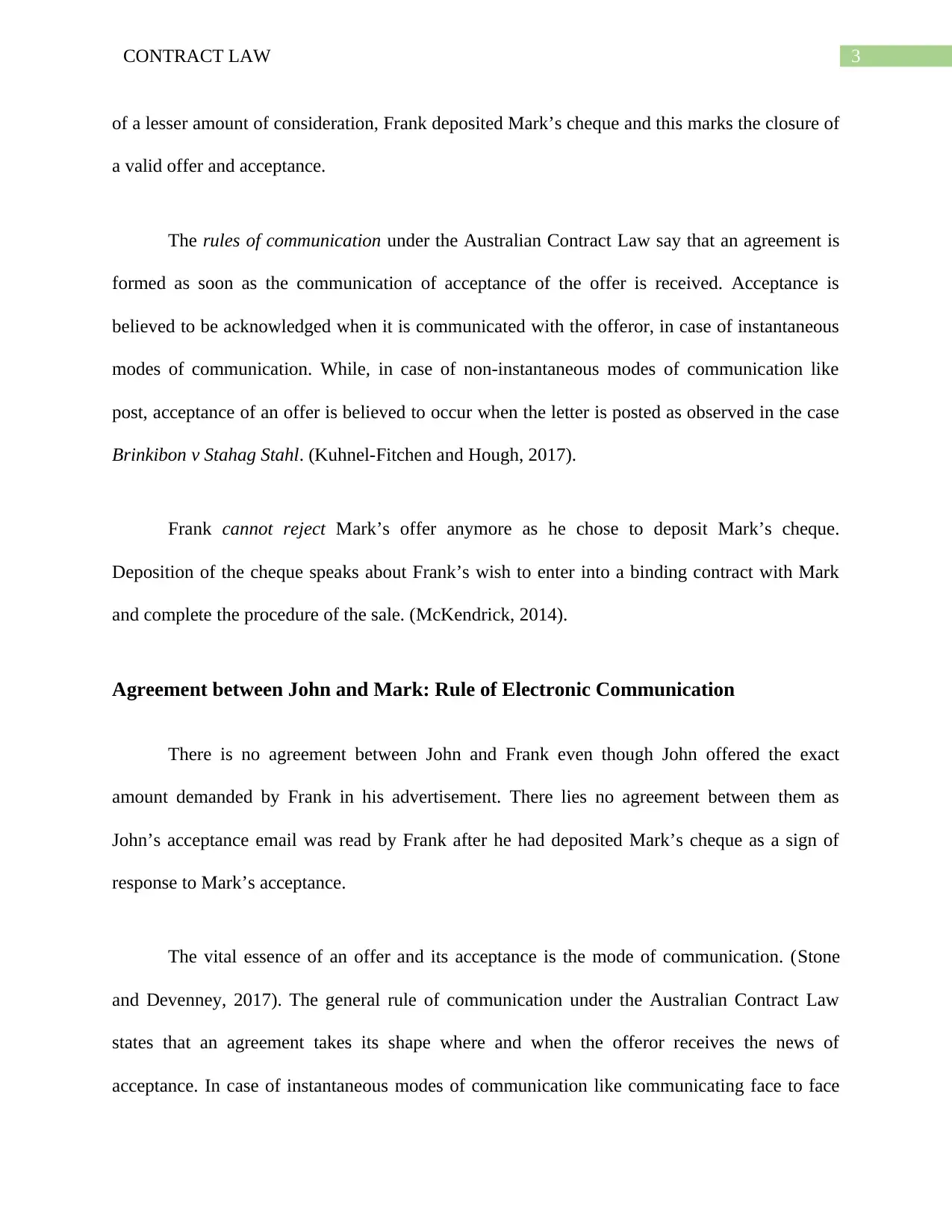
3CONTRACT LAW
of a lesser amount of consideration, Frank deposited Mark’s cheque and this marks the closure of
a valid offer and acceptance.
The rules of communication under the Australian Contract Law say that an agreement is
formed as soon as the communication of acceptance of the offer is received. Acceptance is
believed to be acknowledged when it is communicated with the offeror, in case of instantaneous
modes of communication. While, in case of non-instantaneous modes of communication like
post, acceptance of an offer is believed to occur when the letter is posted as observed in the case
Brinkibon v Stahag Stahl. (Kuhnel-Fitchen and Hough, 2017).
Frank cannot reject Mark’s offer anymore as he chose to deposit Mark’s cheque.
Deposition of the cheque speaks about Frank’s wish to enter into a binding contract with Mark
and complete the procedure of the sale. (McKendrick, 2014).
Agreement between John and Mark: Rule of Electronic Communication
There is no agreement between John and Frank even though John offered the exact
amount demanded by Frank in his advertisement. There lies no agreement between them as
John’s acceptance email was read by Frank after he had deposited Mark’s cheque as a sign of
response to Mark’s acceptance.
The vital essence of an offer and its acceptance is the mode of communication. (Stone
and Devenney, 2017). The general rule of communication under the Australian Contract Law
states that an agreement takes its shape where and when the offeror receives the news of
acceptance. In case of instantaneous modes of communication like communicating face to face
of a lesser amount of consideration, Frank deposited Mark’s cheque and this marks the closure of
a valid offer and acceptance.
The rules of communication under the Australian Contract Law say that an agreement is
formed as soon as the communication of acceptance of the offer is received. Acceptance is
believed to be acknowledged when it is communicated with the offeror, in case of instantaneous
modes of communication. While, in case of non-instantaneous modes of communication like
post, acceptance of an offer is believed to occur when the letter is posted as observed in the case
Brinkibon v Stahag Stahl. (Kuhnel-Fitchen and Hough, 2017).
Frank cannot reject Mark’s offer anymore as he chose to deposit Mark’s cheque.
Deposition of the cheque speaks about Frank’s wish to enter into a binding contract with Mark
and complete the procedure of the sale. (McKendrick, 2014).
Agreement between John and Mark: Rule of Electronic Communication
There is no agreement between John and Frank even though John offered the exact
amount demanded by Frank in his advertisement. There lies no agreement between them as
John’s acceptance email was read by Frank after he had deposited Mark’s cheque as a sign of
response to Mark’s acceptance.
The vital essence of an offer and its acceptance is the mode of communication. (Stone
and Devenney, 2017). The general rule of communication under the Australian Contract Law
states that an agreement takes its shape where and when the offeror receives the news of
acceptance. In case of instantaneous modes of communication like communicating face to face
Secure Best Marks with AI Grader
Need help grading? Try our AI Grader for instant feedback on your assignments.
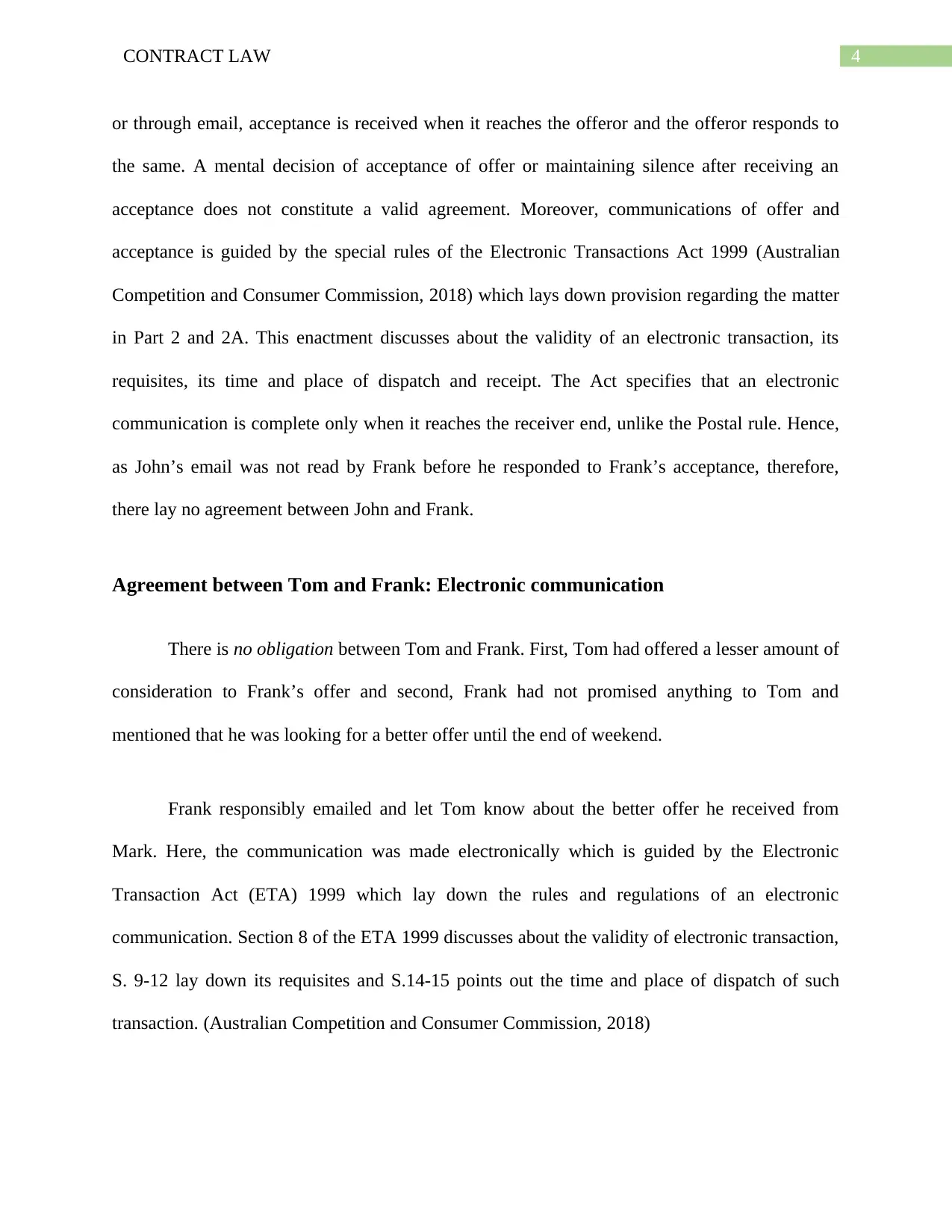
4CONTRACT LAW
or through email, acceptance is received when it reaches the offeror and the offeror responds to
the same. A mental decision of acceptance of offer or maintaining silence after receiving an
acceptance does not constitute a valid agreement. Moreover, communications of offer and
acceptance is guided by the special rules of the Electronic Transactions Act 1999 (Australian
Competition and Consumer Commission, 2018) which lays down provision regarding the matter
in Part 2 and 2A. This enactment discusses about the validity of an electronic transaction, its
requisites, its time and place of dispatch and receipt. The Act specifies that an electronic
communication is complete only when it reaches the receiver end, unlike the Postal rule. Hence,
as John’s email was not read by Frank before he responded to Frank’s acceptance, therefore,
there lay no agreement between John and Frank.
Agreement between Tom and Frank: Electronic communication
There is no obligation between Tom and Frank. First, Tom had offered a lesser amount of
consideration to Frank’s offer and second, Frank had not promised anything to Tom and
mentioned that he was looking for a better offer until the end of weekend.
Frank responsibly emailed and let Tom know about the better offer he received from
Mark. Here, the communication was made electronically which is guided by the Electronic
Transaction Act (ETA) 1999 which lay down the rules and regulations of an electronic
communication. Section 8 of the ETA 1999 discusses about the validity of electronic transaction,
S. 9-12 lay down its requisites and S.14-15 points out the time and place of dispatch of such
transaction. (Australian Competition and Consumer Commission, 2018)
or through email, acceptance is received when it reaches the offeror and the offeror responds to
the same. A mental decision of acceptance of offer or maintaining silence after receiving an
acceptance does not constitute a valid agreement. Moreover, communications of offer and
acceptance is guided by the special rules of the Electronic Transactions Act 1999 (Australian
Competition and Consumer Commission, 2018) which lays down provision regarding the matter
in Part 2 and 2A. This enactment discusses about the validity of an electronic transaction, its
requisites, its time and place of dispatch and receipt. The Act specifies that an electronic
communication is complete only when it reaches the receiver end, unlike the Postal rule. Hence,
as John’s email was not read by Frank before he responded to Frank’s acceptance, therefore,
there lay no agreement between John and Frank.
Agreement between Tom and Frank: Electronic communication
There is no obligation between Tom and Frank. First, Tom had offered a lesser amount of
consideration to Frank’s offer and second, Frank had not promised anything to Tom and
mentioned that he was looking for a better offer until the end of weekend.
Frank responsibly emailed and let Tom know about the better offer he received from
Mark. Here, the communication was made electronically which is guided by the Electronic
Transaction Act (ETA) 1999 which lay down the rules and regulations of an electronic
communication. Section 8 of the ETA 1999 discusses about the validity of electronic transaction,
S. 9-12 lay down its requisites and S.14-15 points out the time and place of dispatch of such
transaction. (Australian Competition and Consumer Commission, 2018)
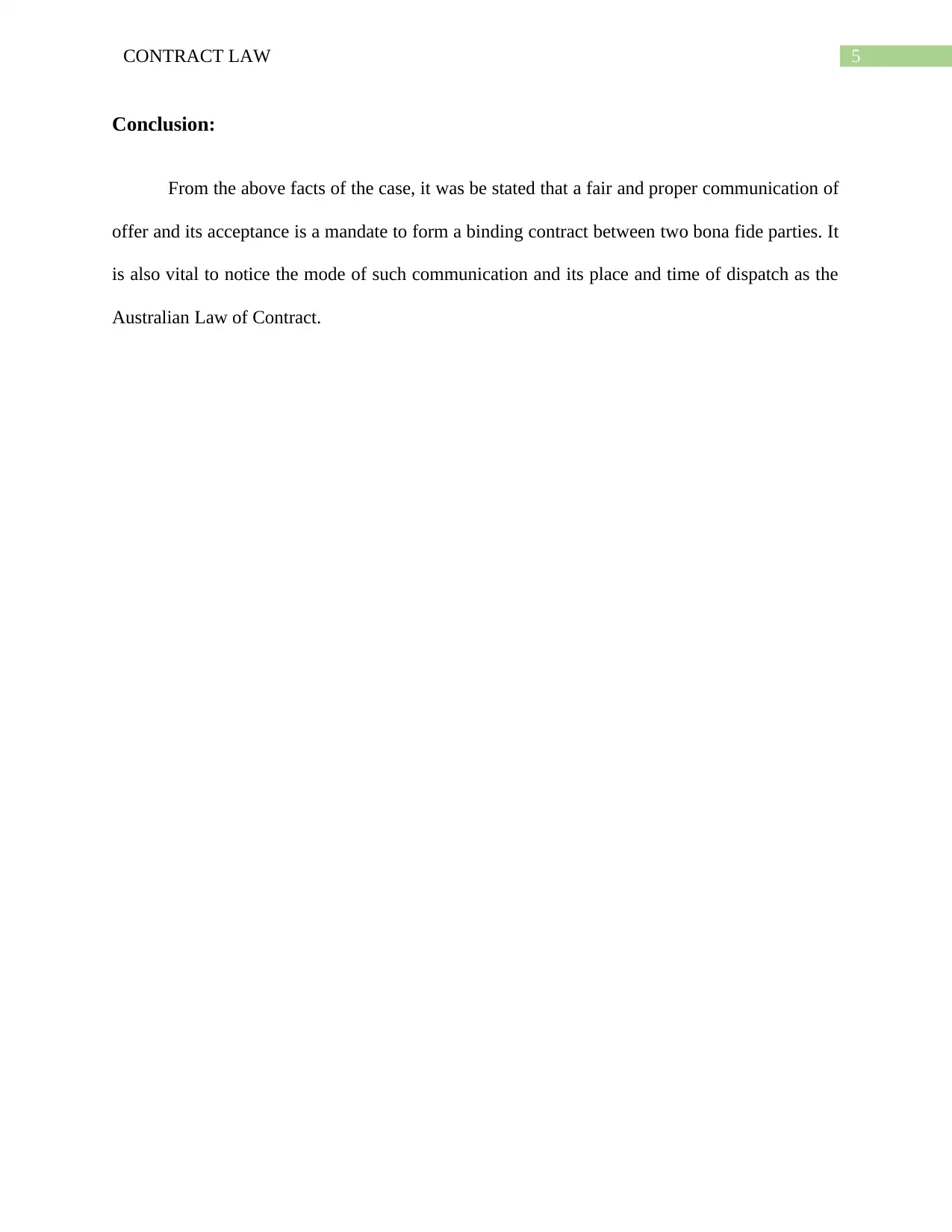
5CONTRACT LAW
Conclusion:
From the above facts of the case, it was be stated that a fair and proper communication of
offer and its acceptance is a mandate to form a binding contract between two bona fide parties. It
is also vital to notice the mode of such communication and its place and time of dispatch as the
Australian Law of Contract.
Conclusion:
From the above facts of the case, it was be stated that a fair and proper communication of
offer and its acceptance is a mandate to form a binding contract between two bona fide parties. It
is also vital to notice the mode of such communication and its place and time of dispatch as the
Australian Law of Contract.
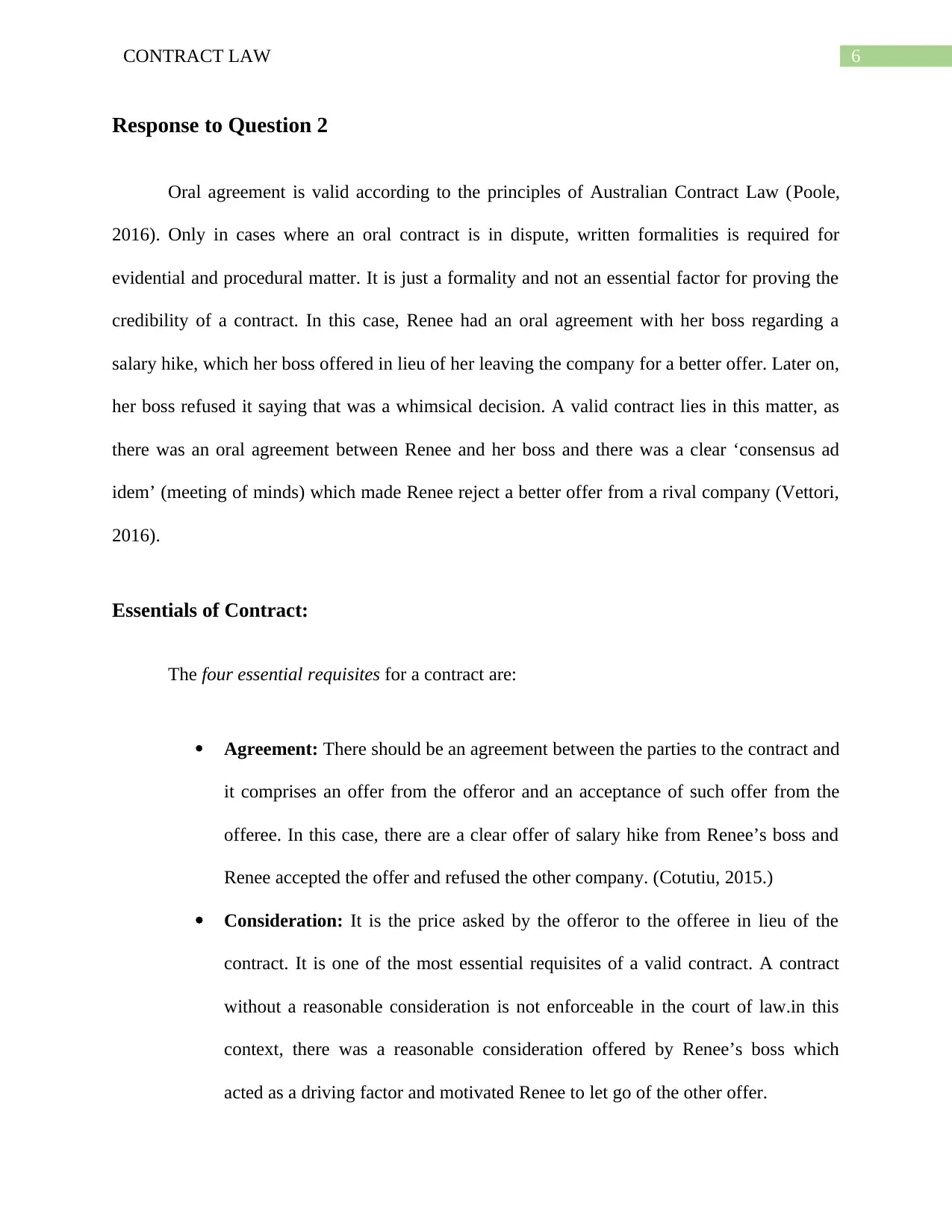
6CONTRACT LAW
Response to Question 2
Oral agreement is valid according to the principles of Australian Contract Law (Poole,
2016). Only in cases where an oral contract is in dispute, written formalities is required for
evidential and procedural matter. It is just a formality and not an essential factor for proving the
credibility of a contract. In this case, Renee had an oral agreement with her boss regarding a
salary hike, which her boss offered in lieu of her leaving the company for a better offer. Later on,
her boss refused it saying that was a whimsical decision. A valid contract lies in this matter, as
there was an oral agreement between Renee and her boss and there was a clear ‘consensus ad
idem’ (meeting of minds) which made Renee reject a better offer from a rival company (Vettori,
2016).
Essentials of Contract:
The four essential requisites for a contract are:
Agreement: There should be an agreement between the parties to the contract and
it comprises an offer from the offeror and an acceptance of such offer from the
offeree. In this case, there are a clear offer of salary hike from Renee’s boss and
Renee accepted the offer and refused the other company. (Cotutiu, 2015.)
Consideration: It is the price asked by the offeror to the offeree in lieu of the
contract. It is one of the most essential requisites of a valid contract. A contract
without a reasonable consideration is not enforceable in the court of law.in this
context, there was a reasonable consideration offered by Renee’s boss which
acted as a driving factor and motivated Renee to let go of the other offer.
Response to Question 2
Oral agreement is valid according to the principles of Australian Contract Law (Poole,
2016). Only in cases where an oral contract is in dispute, written formalities is required for
evidential and procedural matter. It is just a formality and not an essential factor for proving the
credibility of a contract. In this case, Renee had an oral agreement with her boss regarding a
salary hike, which her boss offered in lieu of her leaving the company for a better offer. Later on,
her boss refused it saying that was a whimsical decision. A valid contract lies in this matter, as
there was an oral agreement between Renee and her boss and there was a clear ‘consensus ad
idem’ (meeting of minds) which made Renee reject a better offer from a rival company (Vettori,
2016).
Essentials of Contract:
The four essential requisites for a contract are:
Agreement: There should be an agreement between the parties to the contract and
it comprises an offer from the offeror and an acceptance of such offer from the
offeree. In this case, there are a clear offer of salary hike from Renee’s boss and
Renee accepted the offer and refused the other company. (Cotutiu, 2015.)
Consideration: It is the price asked by the offeror to the offeree in lieu of the
contract. It is one of the most essential requisites of a valid contract. A contract
without a reasonable consideration is not enforceable in the court of law.in this
context, there was a reasonable consideration offered by Renee’s boss which
acted as a driving factor and motivated Renee to let go of the other offer.
Paraphrase This Document
Need a fresh take? Get an instant paraphrase of this document with our AI Paraphraser
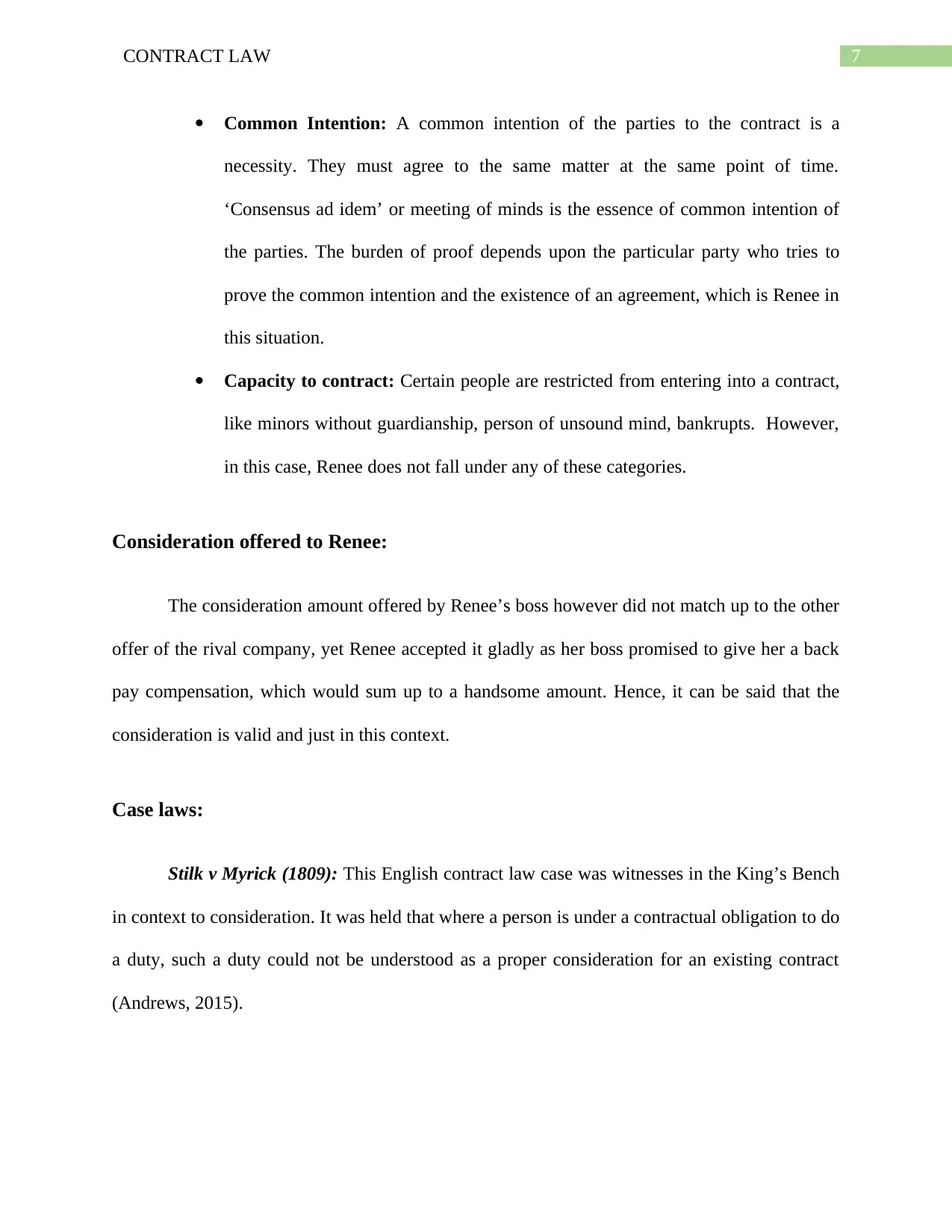
7CONTRACT LAW
Common Intention: A common intention of the parties to the contract is a
necessity. They must agree to the same matter at the same point of time.
‘Consensus ad idem’ or meeting of minds is the essence of common intention of
the parties. The burden of proof depends upon the particular party who tries to
prove the common intention and the existence of an agreement, which is Renee in
this situation.
Capacity to contract: Certain people are restricted from entering into a contract,
like minors without guardianship, person of unsound mind, bankrupts. However,
in this case, Renee does not fall under any of these categories.
Consideration offered to Renee:
The consideration amount offered by Renee’s boss however did not match up to the other
offer of the rival company, yet Renee accepted it gladly as her boss promised to give her a back
pay compensation, which would sum up to a handsome amount. Hence, it can be said that the
consideration is valid and just in this context.
Case laws:
Stilk v Myrick (1809): This English contract law case was witnesses in the King’s Bench
in context to consideration. It was held that where a person is under a contractual obligation to do
a duty, such a duty could not be understood as a proper consideration for an existing contract
(Andrews, 2015).
Common Intention: A common intention of the parties to the contract is a
necessity. They must agree to the same matter at the same point of time.
‘Consensus ad idem’ or meeting of minds is the essence of common intention of
the parties. The burden of proof depends upon the particular party who tries to
prove the common intention and the existence of an agreement, which is Renee in
this situation.
Capacity to contract: Certain people are restricted from entering into a contract,
like minors without guardianship, person of unsound mind, bankrupts. However,
in this case, Renee does not fall under any of these categories.
Consideration offered to Renee:
The consideration amount offered by Renee’s boss however did not match up to the other
offer of the rival company, yet Renee accepted it gladly as her boss promised to give her a back
pay compensation, which would sum up to a handsome amount. Hence, it can be said that the
consideration is valid and just in this context.
Case laws:
Stilk v Myrick (1809): This English contract law case was witnesses in the King’s Bench
in context to consideration. It was held that where a person is under a contractual obligation to do
a duty, such a duty could not be understood as a proper consideration for an existing contract
(Andrews, 2015).
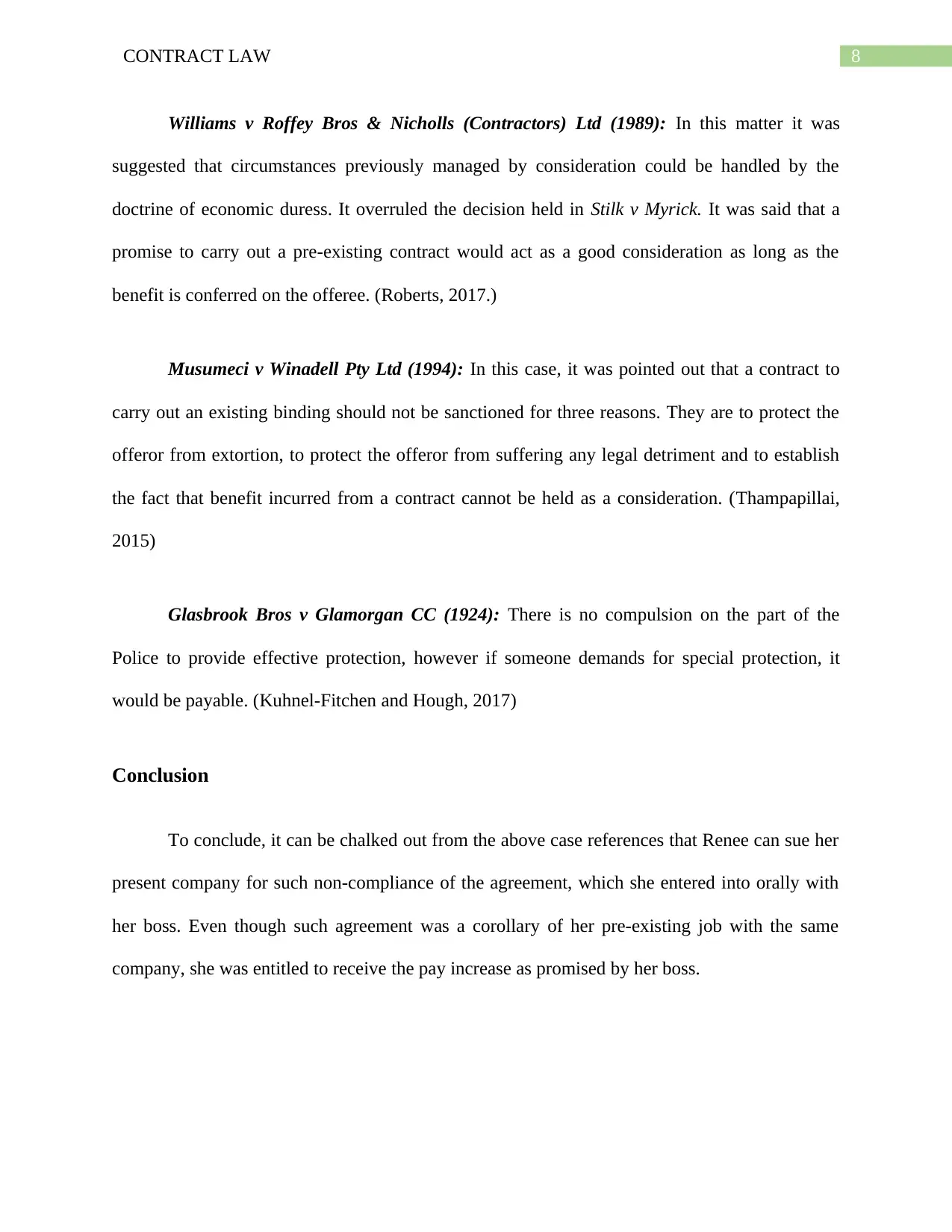
8CONTRACT LAW
Williams v Roffey Bros & Nicholls (Contractors) Ltd (1989): In this matter it was
suggested that circumstances previously managed by consideration could be handled by the
doctrine of economic duress. It overruled the decision held in Stilk v Myrick. It was said that a
promise to carry out a pre-existing contract would act as a good consideration as long as the
benefit is conferred on the offeree. (Roberts, 2017.)
Musumeci v Winadell Pty Ltd (1994): In this case, it was pointed out that a contract to
carry out an existing binding should not be sanctioned for three reasons. They are to protect the
offeror from extortion, to protect the offeror from suffering any legal detriment and to establish
the fact that benefit incurred from a contract cannot be held as a consideration. (Thampapillai,
2015)
Glasbrook Bros v Glamorgan CC (1924): There is no compulsion on the part of the
Police to provide effective protection, however if someone demands for special protection, it
would be payable. (Kuhnel-Fitchen and Hough, 2017)
Conclusion
To conclude, it can be chalked out from the above case references that Renee can sue her
present company for such non-compliance of the agreement, which she entered into orally with
her boss. Even though such agreement was a corollary of her pre-existing job with the same
company, she was entitled to receive the pay increase as promised by her boss.
Williams v Roffey Bros & Nicholls (Contractors) Ltd (1989): In this matter it was
suggested that circumstances previously managed by consideration could be handled by the
doctrine of economic duress. It overruled the decision held in Stilk v Myrick. It was said that a
promise to carry out a pre-existing contract would act as a good consideration as long as the
benefit is conferred on the offeree. (Roberts, 2017.)
Musumeci v Winadell Pty Ltd (1994): In this case, it was pointed out that a contract to
carry out an existing binding should not be sanctioned for three reasons. They are to protect the
offeror from extortion, to protect the offeror from suffering any legal detriment and to establish
the fact that benefit incurred from a contract cannot be held as a consideration. (Thampapillai,
2015)
Glasbrook Bros v Glamorgan CC (1924): There is no compulsion on the part of the
Police to provide effective protection, however if someone demands for special protection, it
would be payable. (Kuhnel-Fitchen and Hough, 2017)
Conclusion
To conclude, it can be chalked out from the above case references that Renee can sue her
present company for such non-compliance of the agreement, which she entered into orally with
her boss. Even though such agreement was a corollary of her pre-existing job with the same
company, she was entitled to receive the pay increase as promised by her boss.
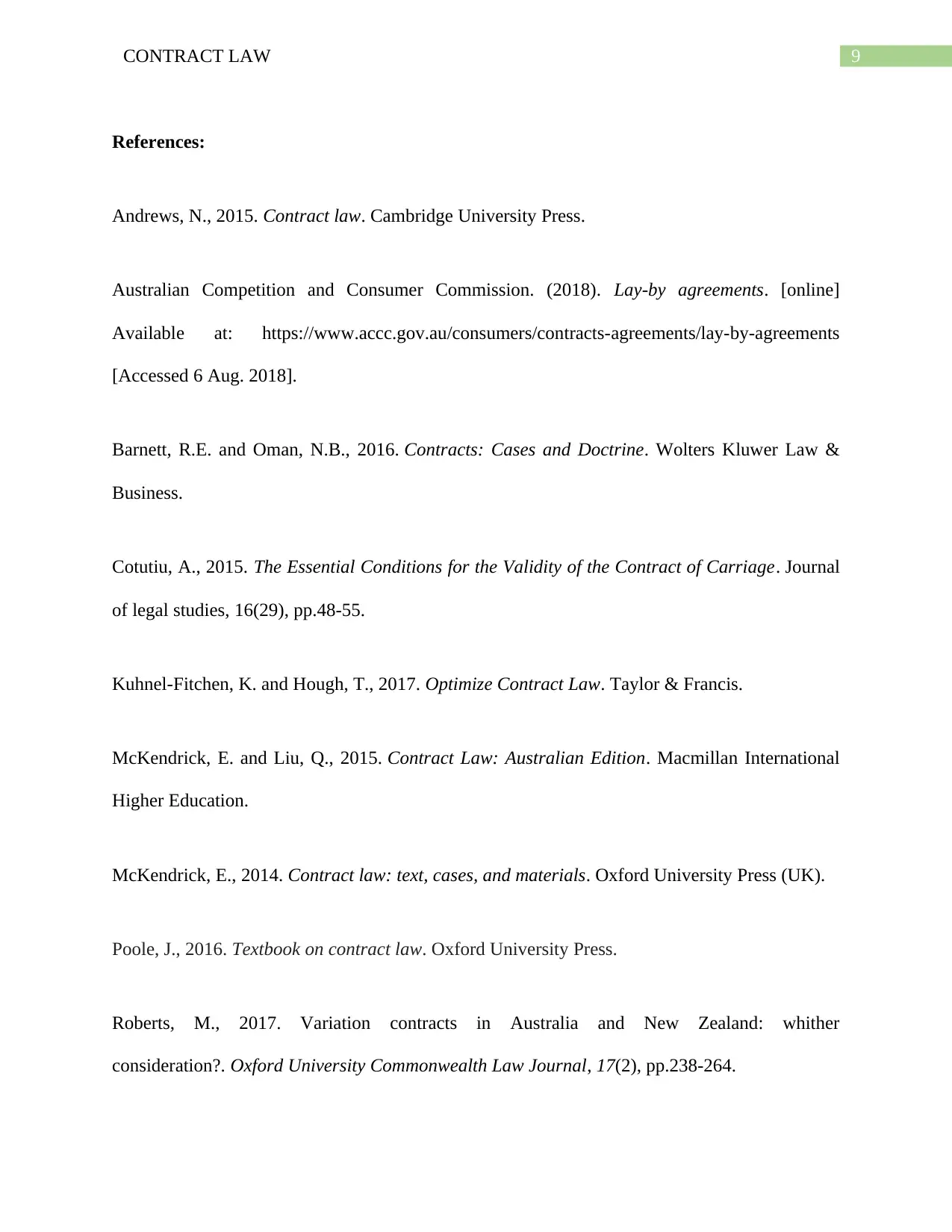
9CONTRACT LAW
References:
Andrews, N., 2015. Contract law. Cambridge University Press.
Australian Competition and Consumer Commission. (2018). Lay-by agreements. [online]
Available at: https://www.accc.gov.au/consumers/contracts-agreements/lay-by-agreements
[Accessed 6 Aug. 2018].
Barnett, R.E. and Oman, N.B., 2016. Contracts: Cases and Doctrine. Wolters Kluwer Law &
Business.
Cotutiu, A., 2015. The Essential Conditions for the Validity of the Contract of Carriage. Journal
of legal studies, 16(29), pp.48-55.
Kuhnel-Fitchen, K. and Hough, T., 2017. Optimize Contract Law. Taylor & Francis.
McKendrick, E. and Liu, Q., 2015. Contract Law: Australian Edition. Macmillan International
Higher Education.
McKendrick, E., 2014. Contract law: text, cases, and materials. Oxford University Press (UK).
Poole, J., 2016. Textbook on contract law. Oxford University Press.
Roberts, M., 2017. Variation contracts in Australia and New Zealand: whither
consideration?. Oxford University Commonwealth Law Journal, 17(2), pp.238-264.
References:
Andrews, N., 2015. Contract law. Cambridge University Press.
Australian Competition and Consumer Commission. (2018). Lay-by agreements. [online]
Available at: https://www.accc.gov.au/consumers/contracts-agreements/lay-by-agreements
[Accessed 6 Aug. 2018].
Barnett, R.E. and Oman, N.B., 2016. Contracts: Cases and Doctrine. Wolters Kluwer Law &
Business.
Cotutiu, A., 2015. The Essential Conditions for the Validity of the Contract of Carriage. Journal
of legal studies, 16(29), pp.48-55.
Kuhnel-Fitchen, K. and Hough, T., 2017. Optimize Contract Law. Taylor & Francis.
McKendrick, E. and Liu, Q., 2015. Contract Law: Australian Edition. Macmillan International
Higher Education.
McKendrick, E., 2014. Contract law: text, cases, and materials. Oxford University Press (UK).
Poole, J., 2016. Textbook on contract law. Oxford University Press.
Roberts, M., 2017. Variation contracts in Australia and New Zealand: whither
consideration?. Oxford University Commonwealth Law Journal, 17(2), pp.238-264.
Secure Best Marks with AI Grader
Need help grading? Try our AI Grader for instant feedback on your assignments.
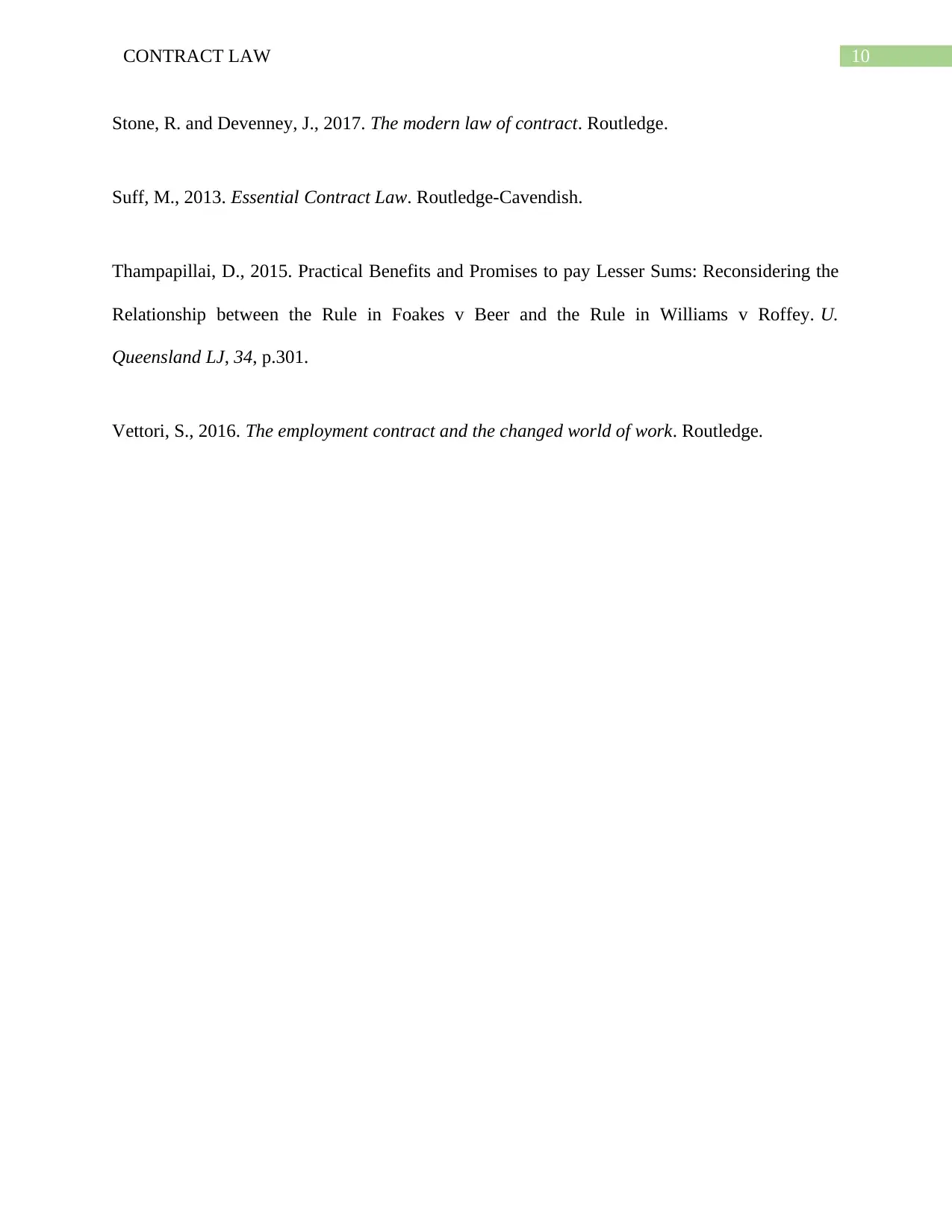
10CONTRACT LAW
Stone, R. and Devenney, J., 2017. The modern law of contract. Routledge.
Suff, M., 2013. Essential Contract Law. Routledge-Cavendish.
Thampapillai, D., 2015. Practical Benefits and Promises to pay Lesser Sums: Reconsidering the
Relationship between the Rule in Foakes v Beer and the Rule in Williams v Roffey. U.
Queensland LJ, 34, p.301.
Vettori, S., 2016. The employment contract and the changed world of work. Routledge.
Stone, R. and Devenney, J., 2017. The modern law of contract. Routledge.
Suff, M., 2013. Essential Contract Law. Routledge-Cavendish.
Thampapillai, D., 2015. Practical Benefits and Promises to pay Lesser Sums: Reconsidering the
Relationship between the Rule in Foakes v Beer and the Rule in Williams v Roffey. U.
Queensland LJ, 34, p.301.
Vettori, S., 2016. The employment contract and the changed world of work. Routledge.
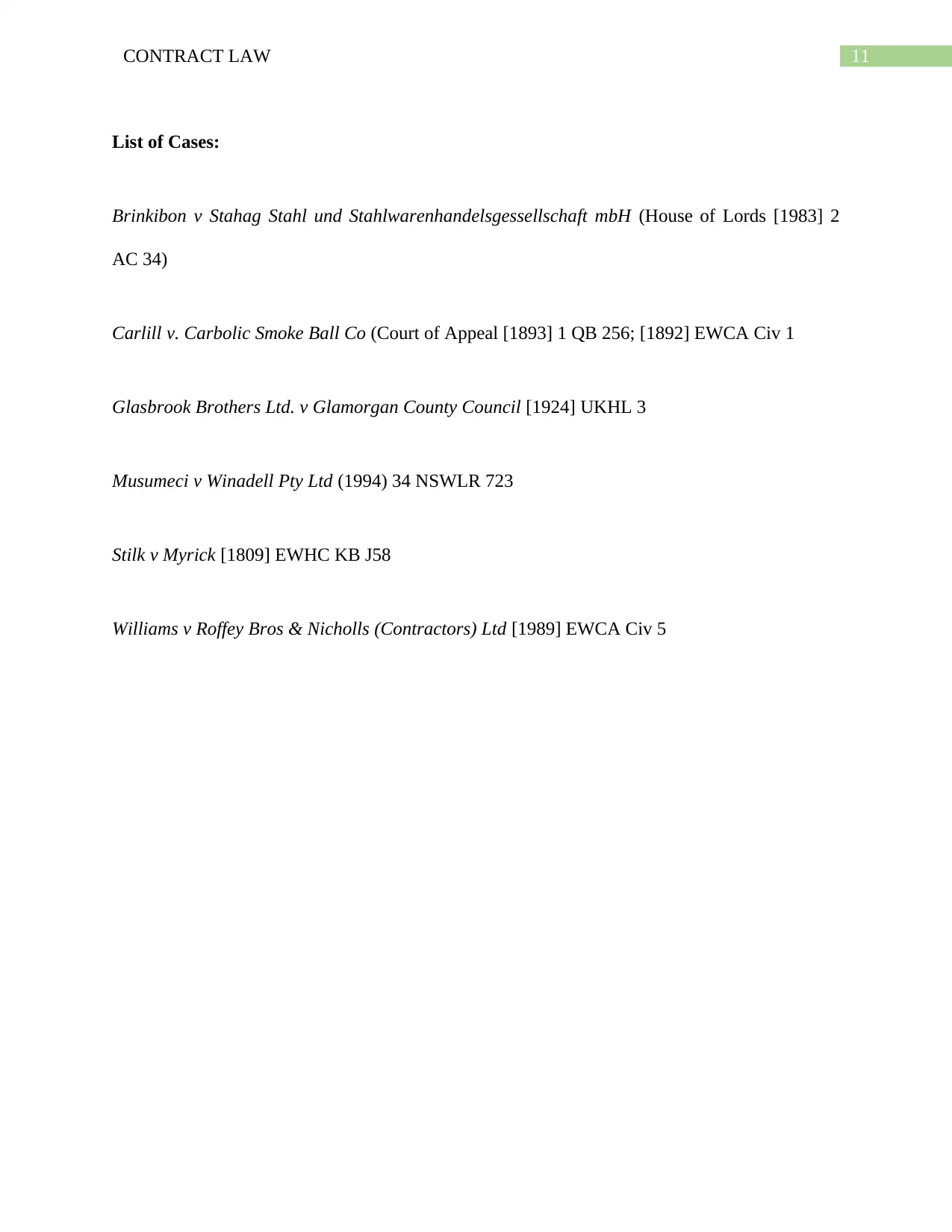
11CONTRACT LAW
List of Cases:
Brinkibon v Stahag Stahl und Stahlwarenhandelsgessellschaft mbH (House of Lords [1983] 2
AC 34)
Carlill v. Carbolic Smoke Ball Co (Court of Appeal [1893] 1 QB 256; [1892] EWCA Civ 1
Glasbrook Brothers Ltd. v Glamorgan County Council [1924] UKHL 3
Musumeci v Winadell Pty Ltd (1994) 34 NSWLR 723
Stilk v Myrick [1809] EWHC KB J58
Williams v Roffey Bros & Nicholls (Contractors) Ltd [1989] EWCA Civ 5
List of Cases:
Brinkibon v Stahag Stahl und Stahlwarenhandelsgessellschaft mbH (House of Lords [1983] 2
AC 34)
Carlill v. Carbolic Smoke Ball Co (Court of Appeal [1893] 1 QB 256; [1892] EWCA Civ 1
Glasbrook Brothers Ltd. v Glamorgan County Council [1924] UKHL 3
Musumeci v Winadell Pty Ltd (1994) 34 NSWLR 723
Stilk v Myrick [1809] EWHC KB J58
Williams v Roffey Bros & Nicholls (Contractors) Ltd [1989] EWCA Civ 5
1 out of 12
Related Documents
Your All-in-One AI-Powered Toolkit for Academic Success.
+13062052269
info@desklib.com
Available 24*7 on WhatsApp / Email
![[object Object]](/_next/static/media/star-bottom.7253800d.svg)
Unlock your academic potential
© 2024 | Zucol Services PVT LTD | All rights reserved.





